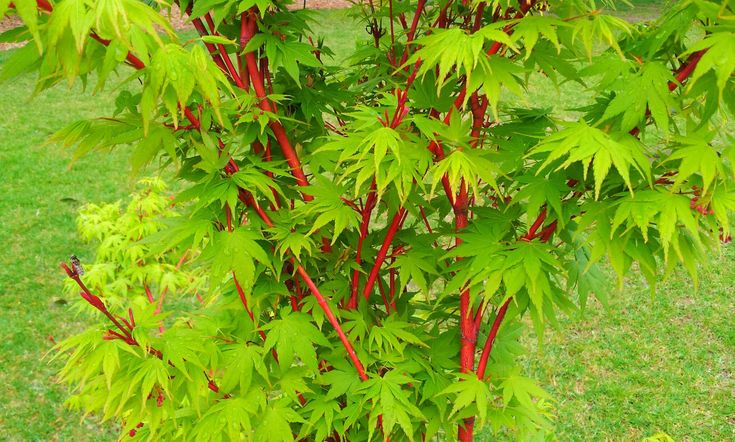Japanese maples are beloved for their graceful shape, stunning leaf colors and textured bark. The coral bark varieties, with their bright red winter twigs add even more visual appeal. However, many gardeners don’t have the space for a large tree. That’s where dwarf coral bark Japanese maples come in! These compact versions pack all the beauty of their larger cousins into a petite package perfect for small yards and containers.
An Eye-Catching Focal Point
A dwarf coral bark Japanese maple makes a striking focal point in any garden. Its vibrant red winter branches stand out against the muted winter landscape. The finely cut green leaves offer a delicate texture. Place one as a specimen plant to draw the eye. Highlight it with underplanting of evergreens, perennials, or groundcovers.
Dwarf coral barks work wonderfully in Asian-inspired gardens. Combine one with grasses ferns and other architectural foliage plants. Let it showcase its sculptural form by giving it some breathing room. Its artful shape and graceful presence will lend a serene elegance.
Year-Round Interest
While dwarf coral bark Japanese maples look their best in winter, they offer multi-season appeal.
In spring, new leaves emerge in shades of yellow, orange, or red. This bright new foliage lights up the garden. It forms a striking contrast against the red bark. Leaf colors turn green in summer, then transform into brilliant yellows, oranges, and reds in fall.
The dwarf coral barks keep performing in winter after the leaves drop. The eye-catching red bark steals the show. Its color varies from orange-red to crimson depending on the cultivar and site conditions. Morning sun helps intensify the tones.
Compact Size for Smaller Spaces
Dwarf coral bark Japanese maples reach just 6 to 8 feet tall at maturity. Their compact size makes them ideal choices where space is limited. Use them in place of a large shrub. Tuck them into mixed borders or small island beds. Grow them in containers on a patio or balcony.
Their moderately slow growth rate means they won’t quickly outgrow their space. Proper pruning can keep them at a desired size. But left alone, they remain petite and tidy.
Their non-invasive roots make them good options for growing near foundations and walkways. They’re happy in fairly confined areas. And they add big visual impact in a small amount of ground.
Easy Care for Time-Pressed Gardeners
Japanese maples are so adaptable and carefree that even busy or new gardeners can grow them successfully. The dwarf coral bark varieties are no exception.
They tolerate most soils as long as drainage is good. Average moisture and occasional deep soakings during droughts keep them happy. Mulch around the root zone to help retain soil moisture and suppress weeds.
Japanese maples grow naturally as understory trees. Dwarf coral barks appreciate some shade, especially during hot afternoons in warm climates. But they’ll grow in full sun in cooler areas. Morning sun brings out the best color in the bark.
Pruning needs are minimal. Mostly limit pruning to removing dead or damaged branches as needed. For size control, cut selected branches back to just above an outward facing bud.
Japanese maples have few pests, and dwarf coral barks are no exception. They may occasionally encounter aphids, scale, or verticillium wilt. But they tend to shrug off issues that plague other plants.
In other words, dwarf coral bark Japanese maples offer fabulous, fuss-free beauty. Their compact size makes them ideal accent plants for small yards. Their year-round visual interest adds seasonal flair. Bring one home, and enjoy elegance made easy!
Popular Dwarf Coral Bark Varieties
Many dwarf coral bark Japanese maple varieties wait to enhance your landscape. Here are a few top choices:
-
Fjellheim – This compact grower boasts brilliant red winter stems and lime green spring leaves. Yellow fall color provides extra flair. It usually reaches just 6 to 8 feet tall and wide.
-
Little Sango – A dwarf sport of the classic Sango Kaku coral bark maple, Little Sango is even more petite. It tops out around 6 feet with a vase shape and intensely red winter twigs.
-
Red Dragon – One of the most popular red-leafed dwarf Japanese maples, Red Dragon dazzles with crimson foliage from spring to fall. Red winter bark adds to its year-round appeal. It grows slowly to 6 feet tall and wide.
-
Aka Kawa Hime – Translating to “red bark princess,” this dwarf coral bark charmer grows slowly to just 4 to 6 feet tall. Red stems show off in winter against spring’s light green leaves.
-
Beni Kawa – This upright coral bark reaches 10 to 14 feet tall at maturity – a bit larger than some dwarfs but still compact. Abundant coral-red bark highlights its winter silhouette.
Time to Add Dwarf Drama
Petite yet eye-catching dwarf coral bark Japanese maples let you enjoy graceful maple beauty even in a small garden. They shine as specimens or accents, offering year-round color and elegance. Their easy-going ways ensure success for busy or new gardeners. It’s time to bring a touch of dwarf Japanese maple magic home to your own landscape!
Acer Palmatum ‘Cupid’ Dwarf Coral Bark in the Garden! – Japanese Maples
FAQ
How big does a dwarf coral bark Japanese maple get?
What is the problem with the coral bark Japanese maple tree?
Can coral bark Japanese maples take full sun?
Can you keep a coral bark Japanese maple small?
- The Ultimate Guide to Growing Strawberries in Raised Beds - August 8, 2025
- No-Dig Garden Beds: The Easiest Way to Grow a Beautiful Garden - August 6, 2025
- How to Protect and Preserve Wood for Raised Garden Beds - August 6, 2025

